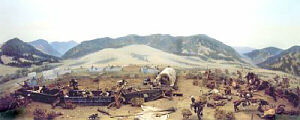

HISTORICITY |
|
During the summer of 1865, the federal government announced plans to support a major road through the Powder River region of northeastern Wyoming Territory to connect with the mining towns in southwestern Montana Territory. Actually, the route already existed—for many years, Indians had followed its general course before John Bozeman and partner John Jacobs charted the trail for use by mining traffic in 1863. The Bozeman Trail (known by several names) branched north from the well-established Oregon Trail at Fort Laramie, crossed the Powder River, skirted the foothills of the Bighorn Mountains, and emerged at Bozeman, which was already linked with nearby Virginia City and northward to Helena. Not only did the Bozeman Trail cut significant miles off existing roads to Montana's mining district, the travel was easier to manage due to more temperate topography. Unfortunately, the road penetrated prime Indian territory causing the Sioux, led by Red Cloud, to go on the warpath in an effort to eradicate the Bozeman Trail traffic. Hence, three guardian forts—Reno, Phil Kearny, and C. F. Smith—were constructed along the Bozeman Trail. During its two-year existence, Fort Phil Kearny was the focal point of two violent battles between area Indians and the U.S. Army. On December 21, 1866, Captain William J. Fetterman was ordered to rescue a besieged woodcutting party about five miles from Fort Phil Kearny. Eager for fight, Fetterman departed from Fort Phil Kearny around noon with a detachment of 80 soldiers. (Emboldened by his extensive combat experience during the Civil War, Fetterman had recently bragged that he could defeat the entire Sioux nation with—coincidentally—just 80 men!) Shortly, a small group of Sioux warriors appeared on Lodge Trail Ridge. Their indignant hoots and gestures, designed as a ruse, lured Fetterman into foolish pursuit. (One of the especially spirited members of the decoy party was a young brave named Crazy Horse.) As the Indians led the calculated chase over the ridge, the soldiers' reckless bravado instantly wilted at the site of some 2,000 warriors waiting in ambush. Within 30 minutes, the entire Fetterman command was dead—Fetterman and his second-in-command evidently shot one another rather than face inevitable brutality and death by the enemy. Just exactly how unbridled was Fetterman's pursuit is open to scholarly debate. The most recent expert opinion supports the idea that Fetterman, upon swallowing the bait, likely discussed strategy with his subordinate officer and proceeded in a manner more deliberate than spontaneous. Furthermore, whether or not Fetterman and another officer intentionally killed each other is not a foregone conclusion, though the story is usually told that way. When reinforcements from Fort Phil Kearny reached the battle site, they were horrified by the soldiers' grotesquely mutilated corpses. The act was judged by many Indians to avenge the hideous massacre of peaceful Cheyennes by territorial militia under Colonel John Chivington at Sand Creek, Colorado Territory, in November of 1864. (While Chivington's attack was exalted by Denver as heroic, a fellow officer described the incident as "cowardly and cold-blooded slaughter." Even the federal government condemned Chivington for "gross and wanton outrages" against the Indians.) Fetterman's defeat was the greatest triumph over the U.S. Army by Northern Plains tribes until Lieutenant Colonel George Armstrong Custer's "Last Stand" at the Little Bighorn nearly a decade later. Several months after the Fetterman Massacre, Red Cloud struck again near Fort Phil Kearny. What took place resembled a scene from an old Hollywood movie. On August 2, Captain James Powell's unit of 31 woodcutters and soldiers, camped about five miles west of the post, repulsed an Indian force of far superior numbers (perhaps 800 or more) by forming wagon boxes into a defensive corral. After five hours of repeated assaults during which the Indians sustained heavy losses (some estimates go as high as 200), Red Cloud withdrew. The bluecoats suffered three killed and two wounded. Despite the disproportionate Indian casualties and the ultimate survival of Powell's command, the Wagon Box Fight is considered a great victory in Sioux lore. Red Cloud's fierce resistance along the Bozeman Trail (coupled with completion of Union Pacific track offering safer passage for white travelers) led to the federal government's decision to extinguish Fort Phil Kearny and its two companion posts. The resulting Treaty of Fort Laramie (1868) essentially restored sovereignty of the Powder River country to the Indians. Hence, Red Cloud earned the distinction as the first—and only, as history unfolded—Indian chief to win a military campaign against the United States. But in more practical terms, by sanctioning the Great Sioux Reservation in present-day western South Dakota, the pact also laid the foundation for increased violence between the U.S. Army and the Northern Plains tribes, and ultimately, the lasting defeat of the American Indian. Fort Phil Kearny is located about 25 miles south of Sheridan, Wyoming, beside Interstate 90 at Exit 44. It is administered by the Wyoming Department of State Parks and Cultural Resources. Operating hours are between noon and 4:00 pm Wednesday through Sunday from October through April, and from 8:00 am to 6:00 pm during May through September. Picnic tables are on site; overnight camping is prohibited. |
DATA |
|
This activity is part of the Little Bighorn Battlefield excursion's second-day schedule. Since students will be doing a good amount of walking outdoors, weather-conscious clothing, including comfortable footwear, is important. Completion of this study guide is optional. Students who answer all questions correctly will receive 25 general bonus points. Please click here for a thorough historical account of Fort Phil Kearny, including the Fetterman Massacre and the Wagon Box Fight. |
QUESTIONS |
|
